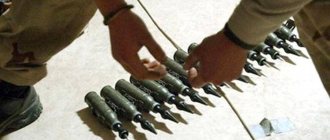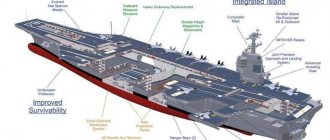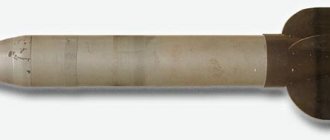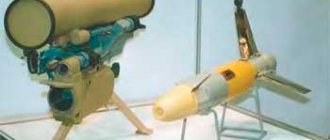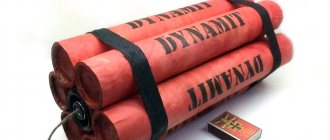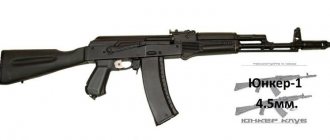Kinetic projectiles and missiles
The basis of modern ground forces is armored vehicles, represented by tanks and infantry fighting vehicles, the weight of which has already exceeded 70 tons (Abrams M1A2 SEP v2, Challenger 2, Merkava Mk.4) and 40 tons (Puma ", "Intention"). In this regard, overcoming the armor protection of these vehicles poses a serious problem for anti-tank ammunition, which includes armor-piercing and cumulative projectiles, rockets and rocket-propelled grenades with kinetic and cumulative warheads, as well as striking elements with an impact core.
Among them, armor-piercing sabot shells and missiles with a kinetic warhead are the most effective. Possessing high armor penetration, they differ from other anti-tank ammunition in their high approach speed, low sensitivity to the effects of dynamic protection, relative independence of the weapon guidance system from natural/artificial interference, and low cost. Moreover, these types of anti-tank ammunition can be guaranteed to overcome the active protection system of armored vehicles, which are increasingly becoming widespread as the frontline for intercepting submunitions.
Currently, only armor-piercing sub-caliber projectiles are accepted for service. They fire mainly from smooth-bore guns of small (30-57 mm), medium (76-125 mm) and large (140-152 mm) calibers. The projectile consists of a two-support drive device, the diameter of which coincides with the diameter of the barrel bore, consisting of sections that are separated after departure from the barrel, and a striking element - an armor-piercing rod, in the nose part of which a ballistic tip is installed, in the tail part - an aerodynamic stabilizer and a tracer charge.
The armor-piercing rod material used is ceramics based on tungsten carbide (density 15.77 g/cc), as well as metal alloys based on uranium (density 19.04 g/cc) or tungsten (density 19.1 g/cm3). cc). The diameter of the armor-piercing rod ranges from 30 mm (outdated models) to 20 mm (modern models). The higher the density of the rod material and the smaller the diameter, the greater the specific pressure the projectile exerts on the armor at the point of its contact with the front end of the rod.
Metal rods have much greater bending strength than ceramic ones, which is very important when a projectile interacts with shrapnel elements of active protection or thrown dynamic protection plates. At the same time, the uranium alloy, despite its slightly lower density, has an advantage over tungsten - the armor penetration of the first is 15-20 percent greater due to the ablative self-sharpening of the rod in the process of penetrating armor, starting from an impact speed of 1600 m/s, provided by modern cannon shots.
Tungsten alloy begins to exhibit ablative self-sharpening starting at 2000 m/s, requiring new ways to accelerate projectiles. At lower speeds, the front end of the rod is flattened, increasing the penetration channel and reducing the depth of penetration of the rod into the armor.
Along with this advantage, the uranium alloy has one drawback - in the event of a nuclear conflict, neutron radiation penetrating into the tank induces secondary radiation in the uranium, affecting the crew. Therefore, in the arsenal of armor-piercing projectiles it is necessary to have models with rods made of both uranium and tungsten alloys, intended for two types of military operations.
Uranium and tungsten alloys also have pyrophoricity - the ignition of heated metal dust particles in air after penetration of armor, which serves as an additional damaging factor. This property manifests itself in them, starting at the same speeds as ablative self-sharpening. Another damaging factor is heavy metal dust, which has a negative biological effect on the crew of enemy tanks.
The driving device is made of aluminum alloy or carbon fiber, the ballistic tip and aerodynamic stabilizer are made of steel. The driving device serves to accelerate the projectile in the bore, after which it is thrown back, so its weight should be minimized by using composite materials instead of aluminum alloy. The aerodynamic stabilizer is exposed to thermal effects from the powder gases generated during the combustion of the powder charge, which can affect the shooting accuracy, and therefore it is made of heat-resistant steel.
The armor penetration of kinetic projectiles and missiles is determined in the form of the thickness of a homogeneous steel plate installed perpendicular to the flight axis of the striking element, or at a certain angle. In the latter case, the reduced penetration of the equivalent thickness of the plate is ahead of the penetration of the plate installed along the normal, due to the large specific loads upon entry and exit of the armor-piercing rod into/from the inclined armor.
When entering inclined armor, the projectile forms a characteristic ridge above the penetration channel. The blades of the aerodynamic stabilizer, when destroyed, leave a characteristic “star” on the armor, by the number of rays of which one can determine the identity of the projectile (Russian - five rays). In the process of penetrating the armor, the rod is intensively ground down and significantly shortens its length. When leaving the armor, it bends elastically and changes the direction of its movement.
A typical representative of the penultimate generation of armor-piercing artillery ammunition is the Russian 125-mm separate-loading shot 3BM19, which includes a 4Zh63 case with the main propellant charge and a 3BM44M case containing an additional propellant charge and the 3BM42M Lekalo sub-caliber projectile itself. Designed for use in the 2A46M1 gun and newer modifications. The dimensions of the shot allow it to be placed only in modified versions of the automatic loader for T-90 tanks.
The ceramic core of the projectile is made of tungsten carbide, placed in a steel protective casing. The driving device is made of carbon fiber. The material used for the cartridge cases (except for the steel tray of the main propellant charge) was cardboard impregnated with trinitrotoluene. The length of the cartridge case with the projectile is 740 mm, the length of the projectile is 730 mm, the length of the armor-piercing rod is 570 mm, the diameter is 22 mm. The weight of the shot is 20.3 kg, the cartridge case with the projectile is 10.7 kg, and the armor-piercing rod is 4.75 kg. The initial velocity of the projectile is 1750 m/s, armor penetration at a distance of 2000 meters along the normal 650 mm of homogeneous steel.
The latest generation of Russian armor-piercing artillery ammunition is represented by 125-mm separately loaded rounds 3VBM22 and 3VBM23, loaded with two types of sub-caliber projectiles - respectively 3VBM59 "Svinets-1" with an armor-piercing rod made of tungsten alloy and 3VBM60 with an armor-piercing rod made of uranium alloy. The main propellant charge is loaded into a 4Zh96 Ozon-T cartridge case.
The dimensions of the new projectiles coincide with the dimensions of the Lekalo projectile. Their weight is increased to 5 kg due to the greater density of the rod material. To accelerate heavy projectiles, a larger main propellant charge is used in the barrel, which limits the use of shots including Svinets-1 and Svinets-2 projectiles only to the new 2A82 gun, which has an enlarged charging chamber. Armor penetration at a distance of 2000 meters along the normal line can be estimated as 700 and 800 mm of homogeneous steel, respectively.
Unfortunately, the Lekalo, Svinets-1 and Svinets-2 projectiles have a significant design flaw in the form of centering screws located along the perimeter of the supporting surfaces of the driving devices (protrusions on the front supporting surface and points on the surface of the cartridge case visible in the figure ). The centering screws serve to stablely guide the projectile in the bore, but their heads have a destructive effect on the surface of the bore. In foreign designs of the latest generation, precision obturator rings are used instead of screws, which reduces barrel wear by five times when firing an armor-piercing sabot projectile.
The previous generation of foreign armor-piercing sub-caliber projectiles is represented by the German DM63, which is part of a unitary shot for the standard 120-mm NATO smoothbore gun. The armor-piercing rod is made of tungsten alloy. The weight of the shot is 21.4 kg, the weight of the projectile is 8.35 kg, and the weight of the armor-piercing rod is 5 kg. The shot length is 982 mm, the projectile length is 745 mm, the core length is 570 mm, the diameter is 22 mm. When firing from a cannon with a barrel length of 55 calibers, the initial speed is 1730 m/s, the speed drop along the flight path is stated at 55 m/s for every 1000 meters. Armor penetration at a distance of 2000 meters is normally estimated at 700 mm of homogeneous steel.
The latest generation of foreign armor-piercing sub-caliber projectiles includes the American M829A3, which is also part of the unitary round for the standard 120-mm NATO smoothbore gun. Unlike the D63 projectile, the armor-piercing rod of the M829A3 projectile is made of uranium alloy. The weight of the shot is 22.3 kg, the weight of the projectile is 10 kg, the weight of the armor-piercing rod is 6 kg. The shot length is 982 mm, the projectile length is 924 mm, the core length is 800 mm. When firing from a cannon with a 55-caliber barrel length, the initial speed is 1640 m/s, the speed drop is stated at 59.5 m/s for every 1000 meters. Armor penetration at a distance of 2000 meters is estimated at 850 mm of homogeneous steel.
When comparing the latest generation of Russian and American sub-caliber projectiles equipped with armor-piercing uranium alloy cores, a difference in the level of armor penetration is visible, largely due to the degree of elongation of their striking elements - 26-fold for the rod of the Svinets-2 projectile and 37-fold for the rod M829A3 projectile. In the latter case, a quarter greater specific load is provided at the point of contact between the rod and the armor. In general, the dependence of the armor penetration value of projectiles on the speed, weight and elongation of their striking elements is presented in the following diagram.
An obstacle to increasing the elongation of the striking element and, consequently, the armor penetration of Russian shells is the automatic loader device, first implemented in 1964 in the Soviet T-64 tank and repeated in all subsequent models of domestic tanks, which provides for the horizontal arrangement of shells in a conveyor, the diameter of which is not may exceed the internal width of the body, equal to two meters. Taking into account the diameter of the casing of Russian shells, their length is limited to 740 mm, which is 182 mm less than the length of American shells.
In order to achieve parity with the cannon armament of a potential enemy for our tank building, the primary task for the future is the transition to unitary shots, placed vertically in the automatic loader, the shells of which have a length of at least 924 mm.
Other ways to increase the effectiveness of traditional armor-piercing projectiles without increasing the caliber of guns have practically exhausted themselves due to restrictions on the pressure in the charging chamber of the barrel, developed during the combustion of a powder charge, due to the strength of weapon steel. When moving to a larger caliber, the size of the shots becomes comparable to the width of the tank hull, forcing the shells to be placed in the rear niche of a turret of increased dimensions and a low degree of protection. For comparison, the photo shows a 140 mm caliber shot with a length of 1485 mm next to a mock-up of a 120 mm caliber shot with a length of 982 mm.
In this regard, in the USA, within the framework of the MRM (Mid Range Munition) program, active-missile projectiles MRM-KE with a kinetic warhead and MRM-CE with a cumulative warhead were developed. They are loaded into a standard 120 mm cannon shot cartridge with a propellant charge. The caliber housing of the projectiles contains a radar homing head (GOS), a striking element (an armor-piercing rod or a shaped charge), impulse trajectory correction engines, an accelerating rocket engine and a tail unit. The weight of one projectile is 18 kg, the weight of the armor-piercing rod is 3.7 kg. The initial speed at the muzzle level is 1100 m/s, after completion of the accelerating engine it increases to 1650 m/s.
Even more impressive results were achieved within the framework of the creation of the CKEM (Compact Kinetic Energy Missile) anti-tank kinetic missile, the length of which is 1500 mm, weight 45 kg. The rocket is launched from a transport and launch container using a powder charge, after which the rocket is accelerated by a booster solid propellant engine to a speed of almost 2000 m/s (Mach 6.5) in 0.5 seconds. The subsequent ballistic flight of the missile is carried out under the control of a radar seeker and aerodynamic rudders with stabilization in the air using the tail. The minimum effective firing range is 400 meters. The kinetic energy of the striking element - the armor-piercing rod at the end of the reactive acceleration reaches 10 mJ.
During the tests of the MRM-KE projectiles and the CKEM missile, the main drawback of their design was revealed - unlike sub-caliber armor-piercing projectiles with a detachable leading device, the inertial flight of the striking elements of the caliber projectile and kinetic missile is carried out assembled with a body of large cross-section and increased aerodynamic resistance, which causes a significant drop in speed along the trajectory and a decrease in the effective firing range. In addition, the radar seeker, pulse correction engines and aerodynamic rudders have low weight perfection, which forces the weight of the armor-piercing rod to be reduced, which negatively affects its penetration.
The way out of this situation is seen in the transition to the separation in flight of the caliber body of the projectile/missile and the armor-piercing rod after the completion of the rocket engine, by analogy with the separation of the driving device and the armor-piercing rod included in the sub-caliber projectiles after their departure from the barrel. Separation can be carried out using an expelling powder charge, triggered at the end of the acceleration phase of the flight. The seeker of a reduced size should be located directly in the ballistic tip of the rod, while control of the flight vector must be implemented on new principles.
A similar technical problem was solved within the framework of the BLAM (Barrel Launched Adaptive Munition) project to create small-caliber guided artillery shells, carried out at the AAL (Adaptive Aerostructures Laboratory) at Auburn University for the US Air Force. The goal of the project was to create a compact homing system that combines a target detector, a controlled aerodynamic surface and its drive in one volume.
The developers decided to change the direction of flight by deflecting the head end of the projectile at a small angle. At supersonic speeds, a deflection of a fraction of a degree is quite enough to create a force capable of carrying out a control action. The technical solution was proposed to be simple - the ballistic tip of the projectile rests on a spherical surface, which plays the role of a ball joint; several piezoceramic rods are used to drive the tip, arranged in a circle at an angle to the longitudinal axis. Changing their length depending on the applied voltage, the rods deflect the tip of the projectile to the desired angle and with the desired frequency.
Calculations determined the strength requirements for the control system: - acceleration acceleration up to 20,000 g; — acceleration along the trajectory up to 5,000 g; — projectile speed up to 5000 m/s; — tip deflection angle up to 0.12 degrees; — drive operating frequency up to 200 Hz; — drive power 0.028 Watt.
Recent advances in the miniaturization of infrared radiation sensors, laser accelerometers, computing processors and lithium-ion power sources resistant to high accelerations (such as electronic devices for guided projectiles - the American Excalibur and the Russian Krasnopol) make it possible until 2022 to create and the adoption of kinetic projectiles and missiles with an initial flight speed of over two kilometers per second, which will significantly increase the effectiveness of anti-tank ammunition, and will also make it possible to abandon the use of uranium as part of their destructive elements.
Projectile movement calculator
Our body motion calculator is a tool that will help you analyze the parabolic motion of a body. It can determine flight time as well as speed components, flight range and maximum flight altitude. Keep reading if you want to understand what body motion is, get to know the definition of motion and determine the above values using the equations of body motion.
What is the movement of a body (projectile)? Projectile motion detection
Imagine an archer shooting an arrow into the air. It begins to move up and forward with a slight inclination towards the ground. The further she flies, the slower she rises - and finally she begins to descend, now moving down and forward and finally hitting the ground again. If you could trace its path, it would be a curve called a parabola-shaped path. Any object moving this way moves like a projectile.
There is only one force acting on the projectile - gravity. Air resistance is always ignored. If you were to draw a free body diagram of such an object, you would only need to draw one downward vector and label it "gravity". If any other forces acted on the body, then - by the definition of projectile motion - it would not be a projectile.
Projectile movement calculator
Projectile motion analysis
The movement of the projectile is quite logical. Suppose you know the object's initial velocity V, launch angle α, and initial height h. Our projectile motion calculator does the following to find all the remaining parameters:
1. Calculate the velocity components.
- Velocity and its horizontal and vertical components The horizontal component of velocity Vx is equal to V * cos (α). The vertical velocity component Vy is equal to V * sin (α).
Three vectors - V, Vx and Vy - form a right triangle. If the vertical component of the velocity is 0, then this is the case of horizontal motion of the projectile. If additionally α = 90°, then this is the case of free fall.
2. Write down the equations of motion. Distance
- The horizontal distance traveled can be expressed as x = Vx * t, where t is time. The vertical distance from the ground is described by the formula y = h + Vy * t - g * t² / 2, where g is the acceleration due to gravity.
Speed
- The horizontal speed is Vx. Vertical velocity can be expressed as Vy - g * t.
Acceleration
- The horizontal acceleration is 0. The vertical acceleration is -g (because the projectile is only affected by gravity).
3.Calculate your flight time.
Projectile movement graph: flight time The flight ends when the projectile hits the ground. We can say that this occurs when the vertical distance from the ground is 0. In the case where the initial height is 0, the formula can be written as: Vy * t - g * t² / 2 = 0. Then from this equation, we find that flight time
t = 2 * Vy / g = 2 * V * sin (α) / g.
However, if we throw an object from some height, then the formula does not reduce as well as before, and we get a quadratic equation to solve: h + Vy * t - g * t² / 2 = 0. After solving this problem, we get:
t=/g
4. Calculate the range of the projectile.
Projectile movement graph: range
The range of a projectile is the total horizontal distance traveled during flight. Again, if we launch the object from the ground (initial height = 0), then we can write the formula as R = Vx * t = Vx * 2 * Vy / g. It can also be converted to the form: R = V² * sin (2α) / g
Things get more complicated for an initial height value other than 0. We then need to replace the long formula from the previous step with t:
R = Vx * t = V * cos (α) * / g
5. Calculate the maximum height.
Projectile movement graph: maximum height
When the projectile reaches its maximum height, it stops moving upward and begins to fall. This means that its vertical velocity component changes from positive to negative, in other words, it is 0 for a short time t (Vy = 0).
If Vy - g * t (Vy = 0) = 0, then we can restate this equation to t (Vy = 0) = Vy / g. Now we simply find the vertical distance from the ground at this time: hmax = Vy * t (vy = 0) - g * (t (Vy = 0))² / 2 = Vy² / (2 * g) = V² * sin ( α) ² / (2 * g) Fortunately, in the case of launching a projectile from some initial height h, we just need to add this value to the final formula: hmax = h + V² * sin (α) ² / (2 * g)
Equations of projectile motion
Phew, that was a lot of calculations! Let's summarize to form the most important equations of projectile motion:
Launching an object from the ground (initial height h = 0)
- Horizontal velocity component: Vx = V * cos (α) Vertical velocity component: Vy = V * sin (α) Flight time: t = 2 * Vy / g Projectile range: R = 2 * Vx * Vy / g Maximum altitude: hmax = Vy² / (2 * g)
Launching an object from a certain height (initial height h> 0)
- Horizontal velocity component: Vx = V * cos (α) Vertical velocity component: Vy = V * sin (α) Flight time: t = / g Projectile range: R = Vx * / g Maximum height: hmax = h + Vy² / (2*g)
Using our projectile motion calculator will surely save you a lot of time. It can also work the other way around. For example, enter your flight time, distance, and initial altitude and watch it do all the calculations for you!
FAQ
Should the projectile move horizontally?
No, projectile motion and its equations cover all moving objects where the only force acting on them is gravity. This includes objects that are thrown straight up, those that are thrown horizontally, those that have a horizontal and vertical component, and those that are simply thrown away.
How can a projectile fall around the Earth?
There is only one force acting on the projectile - gravity. This means that the object will eventually fall to Earth. But what if an object is moving horizontally so fast that by the time it reaches the ground, the ground is no longer there? This is the principle on which satellites operate.
How to find acceleration when a projectile moves?
An object in a throwing motion is subject to only one force—gravity. This means that any change in vertical speed is due to the acceleration due to gravity, which on Earth is 9.81 m/s2. In the horizontal direction, the speed does not change, since air resistance is considered negligible, so the acceleration is 0.
What factors influence the motion of a projectile fired horizontally?
The initial velocity, initial height from which the projectile is launched, and gravity will all affect a projectile launched horizontally. Air resistance will also have an effect in real life, but for most theoretical calculations it is negligible and therefore ignored. If the projectile has wings, this will also affect its movement as it will glide.
What is a projectile?
A projectile is an object that moves in the air and has no force acting on it other than the acceleration due to gravity (this means it cannot be self-propelled). You can probably remember many examples: a thrown ball or stone, an arrow from a bow. Even the Moon is a projectile in relation to the Earth!
What are the characteristics of projectile motion?
The properties of projectile motion are that the horizontal speed of an object does not change, that its vertical speed is constantly changing due to gravity, that the shape of its trajectory will be a parabola, and that the object is not affected by air resistance.
Who was the first to accurately describe the movement of a projectile and when?
Galileo was the first person to accurately describe the motion of a projectile, breaking it down into horizontal and vertical components and realizing that the graph of any object's motion will always be a parabola. He described this in his book On the Movement, published around the 1590s.
Why does the projectile fly in a curve?
An object follows a parabola because gravity affects its two components of motion—horizontal and vertical. The horizontal component is not affected by gravity at all, so it changes linearly. However, the vertical part is constantly under the influence of gravity, so it will increase in height and then decrease, accelerating under the influence of gravity.
Why is 45 degrees the optimal angle for projectiles?
The equation for the distance traveled by the projectile under the influence of gravity is sin(2θ)v2/g, where θ is the angle, v is the initial velocity, and g is the acceleration due to gravity. Assuming v2/g is constant, the greatest distance will be when sin(2θ) is maximum, that is, when 2θ = 90 degrees. This means θ = 45 degrees.
